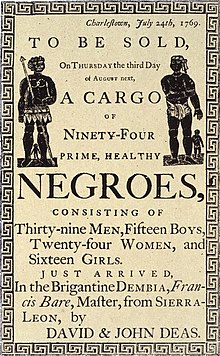Atlantic slave trade
The Atlantic slave trade was the selling of African slaves by Europeans in and around the Atlantic Ocean. It lasted from the 15th century to the 19th century. Most slaves were shipped from West Africa and brought over to the New World on a slave ship.

The slaves on these ships lived in unhealthy conditions. Many died on the ships. The journey by ship was known as the Middle Passage.
Sources of slaves
changeSome slaves were captured in battle or through raids and kidnapping.[1] Some were sold into slavery as punishment or to pay a debt, usually by other Africans.[1]
Then they were shackled together and marched to the coast on journeys lasting weeks or months.[1] When they arrived they were imprisoned in forts where they were purchased by Europeans. Most historians today think that 12 to 13 million Africans arrived in the New World.[2]
The Dahomian army was involved and traded slaves for weapons to protect themselves. King Gezo of Dahomey said in the 1840s:[better source needed]
The slave trade is the ruling principle of my people. It is the source and the glory of their wealth...the mother lulls the child to sleep with notes of triumph over an enemy reduced to slavery...[3]
Slave trade
changeThe slave trade is sometimes called the Maafa by African and African-American scholars.[4] It means catastrophe in the Swahili language.[4]
Some slave ships worked a three-part economic cycle often called the triangular trade.[5] It tied the economies of several regions and continents together.[5] The main triangular trading countries were England, The Netherlands, France, Spain and Portugal.[5] Other ships just worked the slave trade.[better source needed]
Christopher Columbus first came to the Americas in 1492 while seeking the West Indies. European countries started to build colonies in the Americas. This led to an economic reason for the Atlantic slave trade. Slaves were first imported in large numbers for mining and later to grow sugarcane in plantations. Slavery is much more ancient than the transatlantic trade. Slaves were used in many ancient societies.[6]
Historians think that about 4.9 million slaves were brought to Brazil, 1.3 million to the Spanish colonies, and 400 thousand to mainland North America. About 3.9 million were brought to other parts of the Americans, mainly the Caribbean. Records show that only about 9000 slaves were brought to Europe.[7][better source needed]
Abolition and illegal trade
changeIn the 18th century, a small opposition developed against the slave trade in Britain, America, and some parts of Europe.[8] In Britain and America, opposition to the trade was led by the Religious Society of Friends (Quakers) and establishment Evangelicals such as William Wilberforce.[source?]
People who protested against the trade were opposed by the owners of land in the Americas.[9] After 1772, slaves became free upon entering the British Isles.[10] Abolitionism became stronger in the 19th century.[source?]
Denmark was the first European country to ban the slave trade, in 1792, which took effect in 1803.[11][better source needed]
On 22 February 1807, the work of William Wilberforce was rewarded with victory. By 283 votes for to 16 against, the British House of Commons passed the Slave Trade Act to abolish the slave trade.[12][better source needed] The United States abolished it later that year. The Royal Navy set up a blockade of Africa to stop the trade. Treaties with other nations allowed the blockade ships to stop their slave trade.
However, the smuggling of slaves was very common. Hundreds of thousands of Black people were enslaved illegally. New York City was a center for this illegal slave trade. Judges in New York avoided punishing slave traders through the 19th century.[13][better source needed]
Many slaves continued to be sent to Spanish colonies of Cuba, Puerto Rico and much of South America.[14] The slave trade in Brazil was banned in 1831. However, many Brazilians thought it was necessary for their economy, so the country failed to stop it.
Hundreds of thousands more slaves were brought to Brazil in the 1830s and 1840s until the British forced Brazil to end the slave trade.[15][16][better source needed]
Related pages
changeReferences
change- ↑ 1.0 1.1 1.2 "The capture and sale of slaves". International Slave Museum. Retrieved 30 January 2016.
- ↑ Thomas, Hugh 1997. The Slave Trade: the history of the Atlantic slave trade 1440–1870. London: Picador, 1997. ISBN 0-330-35437-X
- ↑ "The Anglo-American Magazine". V. July–December 1854. Retrieved 2 July 2014.
{{cite journal}}: Cite journal requires|journal=(help) - ↑ 4.0 4.1 "Maafa Commemoration". The Free Dictionary/Farlex. Retrieved 30 January 2016.
- ↑ 5.0 5.1 5.2 "Transatlantic Slave Trade". UNESCO. Retrieved 30 January 2016.
- ↑ Greene, Jacqueline. Slavery in Ancient Egypt and Mesopotamia. 2001. ISBN 0-531-16538-8
- ↑ "Trans-Atlantic Slave Trade – Estimates". slavevoyages. Retrieved 5 February 2021.
- ↑ Davis, David Brion 1975. The problem of slavery in the age of revolution: 1770–1823, p. 129.
- ↑ Library of Society of Friends Subject Guide: Abolition of the Slave Trade.
- ↑ Lovejoy, Paul E. 2000. Transformations in slavery: a history of slavery in Africa, Cambridge University Press, p. 290.
- ↑ Kerr, Gordon (June 2012). Short History of Africa: From the Origins of the Human Race to the Arab Spring. Oldacastle Books. ISBN 9781842436349. Retrieved March 8, 2023.
- ↑ William Wilberforce (1759–1833).
- ↑ Vinson, Robert Trent (July 1996). "The Law As Lawbreaker: The Promotion and Encouragement of the Atlantic Slave Trade by the New York Judiciary System, 1857-1862". Afro-Americans in New York Life and History. 20: 35–58 – via In Motion: The African-American Migration Experience.[permanent dead link]
- ↑ Aimes, Hubert H. 1967. A history of slavery in Cuba, 1511 to 1868. New York: Octagon Books.
- ↑ Conrad, Robert (1969-11-01). "The Contraband Slave Trade to Brazil, 1831-1845". Hispanic American Historical Review. 49 (4): 617–638. doi:10.1215/00182168-49.4.617. ISSN 0018-2168.
- ↑ "4.2 Slavery and Abolition in the 19th Century | Brazil: Five Centuries of Change". library.brown.edu. Retrieved 2023-01-09.